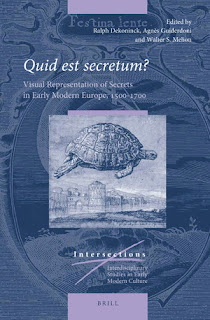Quid est secretum? Visual Representation of Secrets in Early Modern Europe, 1500–1700 is the companion volume to Intersections 65.1, Quid est sacramentum? Visual Representation of Sacred Mysteries in Early Modern Europe, 1400–1700. Whereas the latter volume focused on sacramental mysteries, the current one examines a wider range of secret subjects. The book examines how secret knowledge was represented visually in ways that both revealed and concealed the true nature of that knowledge, giving and yet impeding access to it. In the early modern period, the discursive and symbolical sites for the representation of secrets were closely related to epistemic changes that transformed conceptions of the transmissibility of knowledge.
HPS.CESEE is an online platform about the history of science in Central, Eastern and Southeastern Europe. Our aim is to facilitate the exchange of information among HPS scholars in the region stretching from Prague to Perm and from Tallinn to Tirana. HPS.CESEE is a community project: send us your news to reach a larger audience! You can find us on blogger, telegram, facebook, twitter and BlueSky.
Monday, 19 October 2020
Ralph Dekoninck, Agnès Guiderdoni, and Walter Melion (eds.): Quid est secretum? Visual Representation of Secrets in Early Modern Europe, 1500–1700. Intersections, Volume: 65/2; ISBN: 978-90-04-43225-3
Contributors: Monika Biel, Alicja Bielak, C. Jean Campbell, Tom Conley, Ralph Dekoninck, Peter G.F. Eversmann, Ingrid Falque, Agnès Guiderdoni, Koenraad Jonckheere, Suzanne Karr Schmidt, Stephanie Leitch, Carme López Calderón, Mark A. Meadow, Walter S. Melion, Eelco Nagelsmit, Lars Cyril Nørgaard, Alexandra Onuf, Bret L. Rothstein, Xavier Vert, Madeleine C. Viljoen, Mara R. Wade, Lee Palmer Wandel, and Caecilie Weissert.
URL: https://brill.com/view/title/57612
Table of Contents: Contents
Acknowledgements
Notes on the Editors
Notes on the Contributors
List of Illustrations
Introduction: What’s in a Secret?
Ralph Dekoninck, Agnès Guiderdoni, and Walter S. Melion
1 In the Secrecy of the Cell: Late Medieval Carthusian Devotional Imagery and Meditative Practices in the Low Countries
Ingrid Falque
2 Jesus, Mary, and Joseph as Artisans of the Heart and Soul in Manuscript MPM R 35 Vita S. Ioseph beatissimae Virginis sponsi of ca. 1600
Walter S. Melion
3 Symbols and (Un)concealed Marian Mysteries in the First Litany of Loreto Illustrated with Emblems: Peter Stoergler’s Asma Poeticum(Linz, 1636)
Carme López Calderón
4 ‘Teach Me, Reveal the Secret to My Heart’: the Role of a Spiritual Guide in the Meditative Works of Marcin Hińcza
Alicja Bielak
5 Of Grids and Divine Mystery: Gerard Mercator’s Revelation
Lee Palmer Wandel
6 What Did They See?: Science and Religion in the Anatomical Theatres of the Sixteenth and Seventeenth Centuries
Peter G.F. Eversmann
7 The Sienese Goldsmith and the Secrets of Florentine Disegno
C. Jean Campbell
8 An Open and Shut Case: On the Dialectic of Secrecy and Access in the Early-Modern Kunstkammer
Mark A. Meadow
9 Mysterious Noises: Orphic Strings, Rough Music, and the Sounds of Early Modern Ornament Prints
Madeleine C. Viljoen
10 ‘Insettinghe’ and ‘yegelijcx conversatie’: Understanding of the Image on the Eve of Baroque
Koenraad Jonckheere
11 Roger de Piles and the Secret of Grace
Caecilie Weissert
12 In Abscondito: Visuality and Testimony in Raphael’s Transfiguration
Xavier Vert
13 Secrets of the Dark: Rembrandt’s Entombment (c. 1654)
Alexandra Onuf
14 Poussin and Richeome: Mystery and Figurability
Ralph Dekoninck
15 Portrait or Parable?: Pierre Mignard and the Mystery of Madame de Maintenon
Eelco Nagelsmit & Lars Cyril Nørgaard
16 Secret est à louer: Secrets and Secrecy in French Baroque Cartography, 1580–1640
Tom Conley
17 Hidden in Plain Sight: Melchior Lorck’s Emblematized Adages
Mara R. Wade
18 To Hide is to Reveal: the Paradox of Representing Secrets
Agnès Guiderdoni
19 Getting to How-To: Chiromancy, Physiognomy, Metoscopy and Prints in Secrets’ Service
Stephanie Leitch
20 The Answer Lies in the Eye of the Beholder: the Emblematic Ceiling Program in the Town Hall of Gdańsk
Monika Biel
21 Convents, Condottieri, and Compulsive Gamblers: Hands-On Secrets of Lorenzo Spirito’s Libro
Suzanne Karr Schmidt
22 Secrecy and the Understanding of Small Things in Early Modern Italy
Bret L. Rothstein
Index Nominum
Subscribe to:
Post Comments (Atom)
CFP: Epistemic Passages: Knowledge in Translation
The board of the Society for the History of Science, Medicine, and Technology (GWMT) invites you to the 2026 annual conference in cooperati...
-
2026 Joint ESHS & HSS Meeting, Edinburgh, Scotland, 13-16 July 2026 Call for Proposals: 2026 Joint Meeting of the European Society for ...
-
Call for Papers - International Conference Water Management and Environmental Change in Central Asia and the MENA Region: Politics, society...
-
Call for participants / Summer school: Habsburg Central Europe in Global History, 17th–20th centuries. Prague, 05.05.2025 - 07.05.2025, Dead...

No comments:
Post a Comment